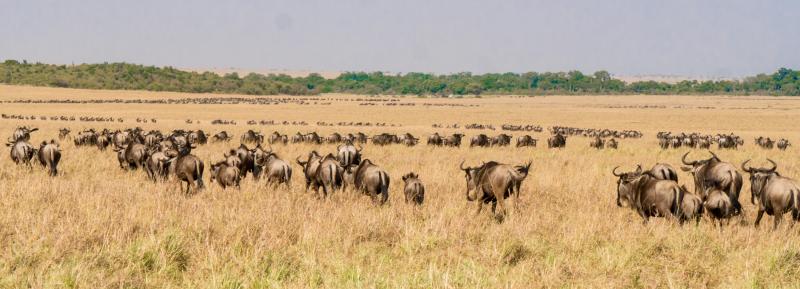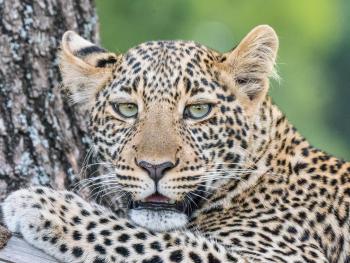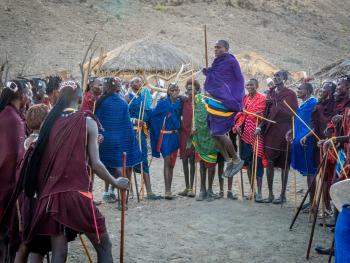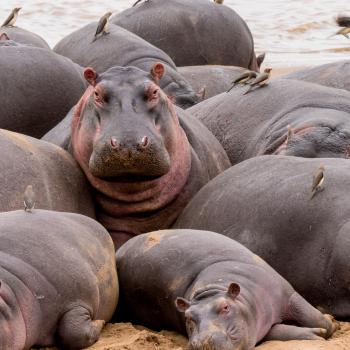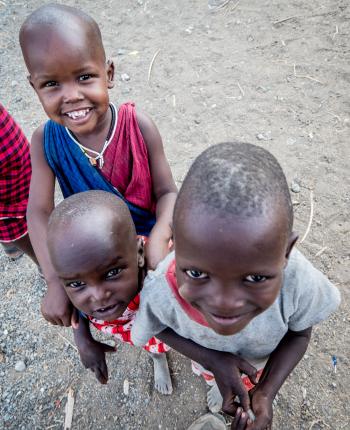Following the migration in Kenya and Tanzania
This article appears on page 6 of the August 2017 issue.
My wife, Sandra, and I had twice previously traveled in Southern Africa with Pierre Duval (Feb. ’13, pg. 46 & March ’14, pg. 26) of BushBaby Safaris (KwaZula-Natal, South Africa; phone +27 [0] 34 212 3216, bushbaby.co.za), and he has become a friend.
When Pierre told us that he was expanding his range to Tanzania and Kenya, we were delighted. Seeing the annual East Africa migration has been on Sandra’s bucket list for years.
This circular wildlife migration is said to include two million wildebeests and one million zebras moving between Tanzania and Kenya as the seasons change. In June and July, the movement is from the Serengeti, in the south, to Kenya, in the north.
We signed right up and worked with Pierre and his wife, Karen, to design a custom 14-day itinerary that included the Ngorongoro Crater and the migration in Tanzania’s Serengeti and Kenya’s Masai (Maasai) Mara.
The Ngorongoro Crater is the world’s largest inactive, nonflooded, intact volcanic caldera, and the 100 square miles it contains serves as a wildlife sanctuary.
In this article I’ll avoid plodding through Day 1, Day 2, etc., and instead try to describe our experiences from several angles, contrasting them with our previous experiences in Southern Africa. (The contrasts were, in fact, quite a surprise.)
Talking about Africa is a little like the Indian fable of the blind men and the elephant: how you describe it depends quite a lot on where you are standing!
Accommodations
On our previous trips to Southern Africa, Sandra and I stayed in very luxurious “tent” cabins, where “tent” just meant that the roof and sides were canvas. Each accommodation usually included a remote-controlled heating/air-conditioning unit, ample electricity and a very nice bathroom with shower. These cabins were on semipermanent wooden frames, each with decking and a front porch.
So when we read that we would be staying in “tented camps” in Tanzania and Kenya, this was our paradigm. The reality was a bit of a surprise.
On this July 2016 trip, “tented camps” almost universally meant actual tents. We usually had a large tent with a Western toilet and shower in a separate room to the rear, with other tents on the grounds for dining and socializing, plus infrastructure tents for staff and to be used for storage and as a kitchen.
Water was often trucked to each camp and hand-carried to pour into an elevated tank to feed the toilet. Often, showers required that we make an appointment for hot water to be poured into the shower tank.
The norm for the availability of electricity was a limited supply from batteries and solar panels.
These tented camps can be struck and moved, leaving the land as it was before the camp was first set up.
This is not to say that we were uncomfortable. Nothing was run-down, and everything was scrupulously clean. Beds, furniture and amenities were excellent.
The weather was mild due to our being at higher altitudes, so a lack of heating or cooling was not an issue. Really, the only significant inconvenience was poor lighting due to the limited electricity.
In virtually all cases, the camps were open to the wild and featured guards at night to drive off animals and escort guests from the dining and lounge tents to their individual sleeping tents. I initially smiled a little bit at the ceremonial-looking spears that the guards carried… until, that is, I realized that our guard’s spear had a solid iron shaft. This was a serious, lion-killing spear, not a decorative toy!
Memorable moments
Of a half-dozen places we stayed, three stood out.
Our first stop was Lake Natron Tented Camp (moivaro.com/lodges/tanzania/lake-natron-tented-camp). The construction of this camp was very unusual, almost rising to the level of folk art.
The tents were on large, free-form concrete and rock bases, with tree trunks and branches gracefully sculpted into the concrete to create the structure, handrails and railings. The sink in our bathroom was sculpted around a sharply curved tree branch that formed the rim.
The decor was, to our eyes, approaching garish, but that is why we travel: to see things we wouldn’t see at home. In this case, we had the chance to sleep inside someone’s sculpture.
The highlight of our two days there was a visit to a Masai village. Through pure luck, we arrived on an evening when the village was celebrating the marriage of the chief’s daughter, in addition to celebrating the circumcision of three boys entering into manhood. The circle dancing was fascinating, featuring competitive jumping by the men.
Both men and women were decked out in their finest. Everyone was welcoming and very open to our taking pictures. We were even invited to visit inside the chief’s home. This was not a made-for-tourists show (which I hate); this was the real deal, and we were fortunate and privileged to be welcomed into it.
Our first Ngorongoro stop was Ngorongoro Farm House (twc
tanzania.com/en/accommodation/ngorongoro-farm-house). This was definitely not a tented camp.
Belying its name, it was a large, modern resort hotel sitting at the center of a farm that grows most of the produce for this and several other accommodations owned by the same firm (Tanganyika Wilderness Camps).
The hospitality offered was beyond excellent, with a staff of, I’m sure, hundreds. The most impressive of them all was the general manager, Mr. Elisha Mwigamba, who was a whirlwind, visiting guest tables, fetching tea, setting up chairs — whatever was needed. No task was too small, and I’m sure he expects and gets the same high performance from his staff.
Our last stop, Sentinel Mara Camp (sentinelmaracamp.com), has to be experienced to be believed. It’s a tented camp, yes, but small and intimate, with oriental carpets, multicourse meals prepared to order and fine wines. Most of the uniformed staff lined up, together with the owners, to greet us on arrival, and from there the hospitality only improved.
The camp, situated on a high bank overlooking the Mara River, featured hippo serenades during the evening and night.
Even the owners were amazing; Peter Twycross is Oxford-educated in archaeology, and his wife, Wendy, is an ethnomusicologist.
One excellent feature at Sentinel was that visitor groups were not combined for game drives. Each group got its own guide/driver and game drive vehicle. This meant that we could reroute, linger or explore during the drive without worrying about others.
We could also leave and return on our own schedule. If you don’t want to leave at oh-dark-thirty for the morning drive, don’t!
Lake Natron
At Lake Natron, the red-orange flamingos were the primary attraction. They get their coloration from eating algae that contains red pigment.
The lake, itself, has a very high mineral and salt content and a high temperature from the hot springs that feed it. This inhospitable environment protects the flamingos (officially called “lesser flamingos”), which are listed as endangered, from predators.
Seeing the thousands of flamingos was impressive, but when we were there, the lake level was low and it was impossible to approach the shy birds, even within 100 yards.
My photos were taken with a very long telephoto lens (800mm) on a tripod, and I could have used a still-longer lens.
Getting to Lake Natron involved a 4-hour drive each way over very rough roads. Absent the luck we had in attending the Masai celebrations I mentioned before, I would say that a visit to Lake Natron is not worth the transport tribulations.
Ngorongoro
The Ngorongoro Crater is home to one of the great concentrations of wildlife in the world. The caldera’s bottom is flat, so it forms a great plain that allows easy animal and bird viewing, even at a distance.
Also, it was quite easy to spot congregations of game-drive vehicles, which indicates a special sighting like a pride of lions.
As in Southern Africa, birds and animals were almost oblivious to our game drive vehicles. At one point, we saw a vehicle that was stopped by a lion sleeping on the road, preventing its passage. I guess when you weigh 400 pounds and have paws the size of dinner plates, you can sleep wherever you like.
The Ngorongoro Crater is a natural enclosure estimated to hold about 25,000 large animals. This population does not participate in the annual migration, so sightings can include thousands of wildebeests, Cape buffaloes and zebras.
During our game drives, it quickly got to the point where we didn’t even slow down for wildebeests or zebras. Too many! Elephants, Cape buffaloes, antelopes and gazelles numbered in the hundreds, as did marabou storks, flamingos, secretary birds, vultures and many other species of large and small birds. We also saw hippos and lions, in smaller quantities, and, of course, warthogs, hyenas and jackals.
The hippos were especially fun. On our previous Southern Africa trips, we never saw hippos onshore. Our photos from the south were typically of nostrils, eyes and the tips of ears sticking out of the water. In Ngorongoro, it was common to see hippos sunning on the riverbanks.
Sadly, we saw no leopards. We didn’t see black rhinos either; they are quickly being poached to extinction almost everywhere in Africa.
Serengeti and Masai Mara
Tanzania’s Serengeti National Park and the adjoining Masai Mara in Kenya are, to the wildlife that live there, all the same area of land. Combined, they cover over 6,000 square miles.
The headline attraction there is the migration.
Immediately upon arriving in the Serengeti, we could see the uncountably large herds of wildebeests and zebras and lines of marching animals getting ready for the migration almost wherever we looked.
We quickly added giraffes and leopards to our wildlife-sighting tally, as the Serengeti is better supplied with trees (food for giraffes and favorite hangouts for leopards) than is Ngorongoro.
An iconic moment of the migration is when a herd of wildebeests or zebras crosses the Mara River, which contains some of the biggest crocodiles in Africa. Reaching up to 16 feet long, these crocs make a nice living taking wildebeests and zebras as they cross.
And the animals know it! They mass in an increasingly larger group for hours, even a full day, before the leaders venture to cross the river. We were able to see and photograph this massing; unfortunately, we were never in position at the right time to see a crossing.
Our guide/driver seemed to have a pretty good sense of when a crossing was imminent, so we didn’t waste a lot of time sitting and waiting. We talked to other travelers, though, who sat for four or five hours and still did not see a crossing.
After three days in Serengeti National Park, we made the short but complex air/ground journey to Kenya’s Masai Mara preserve. This land belongs to the Masai, not to Kenya’s government, so technically it is not a national park. The Masai and the government jointly manage it as a game preserve, however, so the distinction is not that important.
As previously mentioned, our stay there was in the luxurious Sentinel Mara Camp.
We had our best game viewing of the trip during our 2½ days in the Mara. We saw mating lions and hyenas, a cheetah gorging on her kill, and a leopard feeding on a kill she had dragged into a tree. The leopard’s yearling cub even posed on a low tree branch for us.
Giraffes and elephants were everywhere, as were several species of antelope. And, of course, the migrating wildebeest and zebra herds dotted the landscape.
When I say that our best game viewing was in the Mara, it is an observation of our specific experience rather than a prediction of what can be anticipated. If we were going back to the area, we’d probably go to the Mara, based on our experience, but it could easily be that the viewing in Ngorongoro or the Serengeti would be better on that trip. It’s more luck than science.
Getting around
This was a physically tough trip due to the extremely bad roads we encountered everywhere. Whatever you might visualize when I say “bad,” they were worse. We were briefly on one asphalt road connecting Arusha and Dar es Salaam. Other than that, we traveled over rocks, ruts and potholes.
Even roads that one might expect to be good, like the 10- to 15-kilometer drive from the main road to the beautiful Ngorongoro Farm House complex, were awful. Traversing this 15-kilometer distance involved at least a half hour of constant rocking, bouncing, braking, accelerating and boredom.
We had an excellent driver, Goodluck Kombe, but at the end of a long and rough day, followed by that 15 kilometers, I was mad at Pierre, mad at Goodluck and mad at the general situation. Fortunately, though the roads did not get better, my composure and acceptance of the inevitable did improve, making the remainder of the trip more pleasant.
I would caution those with back or other medical problems that would be exacerbated by hours of very rough riding that this is probably not your best choice for a trip. Bathroom opportunities, too, are few and far between.
To get to the Masai Mara from the Serengeti, we flew north to Isbania, on the Kenyan border, debarked and were driven first to obtain entry visas, then on to the airport on the Kenyan side (Migori) for the short flight to the airport at the Masai Mara.
Our excellent guide from Sentinel Mara Camp, Dominic Maitai, picked us up at the airport (and he would return us there a couple of days later for the final internal flight to Nairobi before our departure back to the US).
All flights and ground handling were included in the trip price, and the experience was good. The airplanes were Cessna Caravans, a single-pilot, short-haul turboprops configured with a dozen or so airline-style seats. I am a commercial-rated pilot, and I had no concern at all about the quality or safety of the airplanes and pilots.
Tour details
This was not an inexpensive trip. The tour costs $13,750 per person for two, with a per-person savings of 40% for a group of four.
We were shocked to learn that, for our trip, the park and government fees alone totaled $3,171 (included in the total tour price). Our entry visas into Tanzania added another $100 each, and our entry visas into Kenya each cost $50. We also had to make a last-minute rush visit to our travel clinic to satisfy Kenya’s requirement for yellow fever boosters ($200 each). Our vaccination records were not checked at the border, however.
Game drive vehicles in Southern Africa are typically open, with three or four rows of “stadium style” seating (seats rising higher toward the rear). These provide good photographic options for the six or eight passengers with “window” seats.
On this trip, we found “pop-top” Toyota Land Cruisers to be much more common than the open vehicles. The pop-tops can seat as many as nine guests (though very uncomfortably), but it was necessary to stand in the aisle for photography. For standing, four people is about the limit. When planning a trip, it is important to ask about how you’ll be traveling on game drives.
We didn’t go to Zanzibar, which is typically part of a trip like this. Pierre and Karen had suggested it as the end point for the last couple of days of our itinerary, and many people have since recommended it to us. Our decision to not visit this area rich in history was based on the fact that we had toured East Africa (Ethiopia) in January 2015 and that tour was very history-focused, so on this trip we wanted to concentrate on seeing animals and birds.
As it turned out, the last segment of our trip, at Sentinel Mara Camp, which we substituted for the suggested Zanzibar stop, was the best segment of them all.
Should you go?
We had several discussions with Pierre and generally agree with him that this itinerary would not be a good first trip to Africa. (It was our sixth.) Though the migration and general game-viewing experiences are fantastic, the food and accommodations can be less than top-notch, the cost is high, and the road travel is difficult and uncomfortable.
Alternatively, excellent game viewing can be had in South Africa (Kruger Park), Namibia (Etosha Park), Botswana, Zimbabwe and many other places in the south. Roads there are excellent, facilities range from nice to superb based on how much you want to spend, and the overall trip costs are lower.
But if you are fascinated by the migration, as Sandra was, then the Serengeti/Mara area is the only place to go!
We enjoyed it a lot, but it was tough travel. If you decide to see the migration, go forewarned, with an accommodating attitude, and use a good tour company. I’m sure you’ll enjoy it as much as we did.

